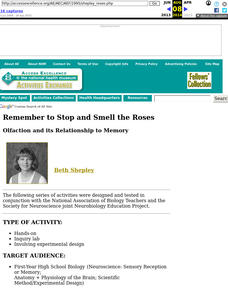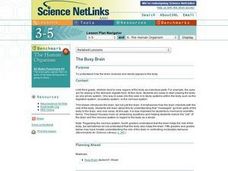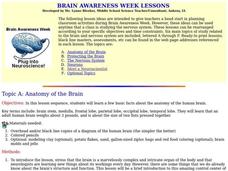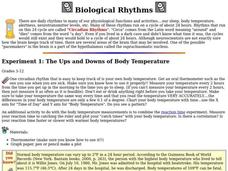University of Minnesota
Virtual Neurons
It's electric! Young anatomists use Virtual Neurons software to build, control, and analyze complex nerve circuits within the body. Colorful and packed with content, class members enjoy interacting with the nervous system at a personal...
Kenan Fellows
Unit 3: How Drugs Enter/Exit the Body
The third of a four-part series on Pharmacology teaches scholars how drugs enter and exit the body, how they act inside the body, how they affect the brain, and more. Over the course of the unit, groups complete two labs and one...
Open Colleges
Your Brain Map: Strategies for Accelerated Learning
The brain is a complex organ with many different structures and functions. An interactive diagram allows learners to explore the different structures while pop-ups describe their functions. Secondary interactives show the structures of...
PBS
Color Code
Don't let your brain play tricks on you! Learners test brain reaction rates while it is receiving multiple stimuli. They time each other reading a set of color words written in different colors and again when they are written in black....
Curated OER
Brain Awareness Week
Students explore human anatomy by completing a list of activities over five days. In this brain science lessons, students examine images of brains and identify the different parts. Students complete an in-class quiz regarding brain...
Curated OER
Brain Awareness Week Lessons
Learners explore the human brain and nervous system. For this brain awareness lesson, students examine specific terms with regards to the human brain. Learners discover the brain's structure and function and how it functions as the...
Curated OER
Remember to Stop and Smell the Roses: Olfaction and its Relationship to Memory
Students discover that olfaction elicits memory associations. They investigate how olfaction compares to other sensory modalities in the formation of memories. This is a hands-on lab activity guaranteed to build memories in your students!
Curated OER
Acting Potential
Students set up a cell membrane with the material provided by their teacher and then arrange beads properly to show how the sodium and potassium ions are arranged. They then make a model representing the axon of a neuron.
Curated OER
Brain Power
In this science worksheet, students investigate the anatomy and function of the human brain. Students read facts about the parts of the brain and what each does. Students compare the size of the human brain to that of other animals....
Curated OER
Throw it Out! (The Senses)
In this senses learning exercise, students read a group of words and determine which word doesn't belong with the others. Students must explain why they chose the word to exclude. This learning exercise has 8 short answer questions.
Curated OER
I Belong To . . . (The Senses)
In this senses worksheet, students match the descriptive words with the body part is belongs to: ear, eye, nose, mouth, or skin. This worksheet has 20 matching questions.
Curated OER
The Busy Brain
Students explore biology by completing a human body worksheet. In this human brain lesson, students identify the different anatomy within the brain and the functions those pieces form. Students read an article about signals in the brain...
Curated OER
How We Perceive Movement, Depth and Illusions
Students examine how depth perception works through a class experiment. They design and perform their own experiment that investigates visual illusions.
Curated OER
Anatomy of the Brain
Students explore human anatomy by completing a quiz. In this brain lesson, students read assigned text which discusses the different elements of the human brain and how they are used in everyday experiences. Students answer a multiple...
Curated OER
Brain Awareness Week
Students explore the brain. In this science lesson, students create a model of the brain and discuss steps taken in order to protect the brain. Students design a container that would protect the brain from injury. Students discuss the...
Curated OER
Mapping the Homunculus
Students determine the relative number of nerve endings located in the skin. By calculating the reciprocal of these measurements, students have the appropriate data for predicting the relative size of the homunculus found on the cerebral...
Curated OER
Taste (Gustation)
Students conduct various experiments to see if different parts of the tongue are more sensitive to different characteristics of food.
Curated OER
Biological Rhythms
Learners conduct experiments to determine their circadian rhythms for a cycle of about 24 hours.
Curated OER
Brain Concentration
Students play a card game to test their memory. Special cards are provided, as well as clear directions.
Curated OER
Building a Clay Neuron
Middle schoolers investigate and then build neurons in this lesson. They are examined as key parts of the brain and nervous system and seen as different from normal cells.
Curated OER
The Musical Mind
Learners go on a tour of how and why music styles have changed over the years, and discover where they can gather some insight about their favorite musical styles and artists. There are excellent websites imbedded in this lesson plan.
Curated OER
Inside Information
Students explore two pathways for information through the nervous system. The pathways for involuntary action or reflex and voluntary responses are built and related to the element of choice.
Curated OER
A Penny Saved is a Penny Heard
In this pennies worksheet, students compare pennies collected to determine the change in sounds of a penny starting from the 1960s. Students record their data in a chart.
Curated OER
Making Blood!
Ninth graders study facts about human blood and what it is made of. In this blood composition lesson students divide into groups and complete several activities.
Other popular searches
- Memory Neuroscience
- Neuroscience Psychology
- Behavioral Neuroscience
- Neuroscience Lessons
- Neuroscience Games
- Neuroscience Labs
- Neuroscience Senses
- Behvaioral Neuroscience
- Neuroscience + Psychology
- Social Neuroscience

























